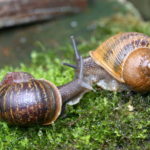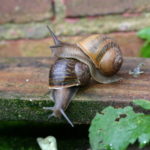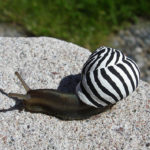Facts about snails
 Snails are not only garden pests, as many people mistakenly believe. For some, these creatures are favorite pets, for someone – an object of close study. There are a lot of snail species in the world, and these creatures have developed amazing life mechanisms in the course of evolutionary processes.
Snails are not only garden pests, as many people mistakenly believe. For some, these creatures are favorite pets, for someone – an object of close study. There are a lot of snail species in the world, and these creatures have developed amazing life mechanisms in the course of evolutionary processes.
- Snails appeared on Earth about 600 million years ago. This allows us to consider them as one of the most ancient inhabitants of our planet, along with jellyfish.
- Snails are one of the most convincing proofs of Darwin’s theory of evolution, they can adapt to almost any habitat.
- These mollusks can be completely drawn into the shell by a special muscle covering the entire body of the cochlea.
- Snails are far from stupid creatures. They are able to think and make decisions based on their life experience.
- Snails are able to crawl along the blade of the knife and not get injured – during movement, the sole of their feet rests on a kind of “cushion” of mucus, which protects the body of the mollusc and helps it move around.
- If the surrounding conditions become unfavorable, the snails can spend up to six months in hibernation. Due to this ability, garden snails tolerate temperatures up to -120 degrees.
- The average life span of snails is 15 years. This is comparable with the life expectancy, for example, of the Amur tiger.
- Most snails are hermaphrodites, that is, females and males at the same time. They do not need a partner to continue the generation.
- At a time, snails lay about 85 eggs, of which the young hatch after a month.
- Shells of almost all snails are twisted clockwise. The strength of this “home” depends on the amount of calcium in the ration of the shellfish.
- Snails do not chew, but they grind food with 25 thousand teeth. Yes, yes, they have more teeth than any shark.
- These creatures are able not only to drink in the usual sense of the word, but also absorb moisture on the surface of their body.
- The sight of snails is so bad that they can only tell the difference from day to night.
- Almost complete absence of sight compensates for a very developed sense of smell – an individual without a shell feels food at a distance of up to two meters.
- Snails are completely devoid of hearing and the ability to produce any sounds. But they have organs of balance and chemical sensation.
- The snail’s horns are the nose turned inside out (all the receptors that people have inside are in the snails are outside).
- Between themselves the snails communicate by touch.
- Snails can carry objects 10 times heavier than themselves.
- The largest snail in the world is the Australian sea. The weight of these mollusks reaches 40 kilograms, and the length is 30 centimeters.
- The color of the shell in all snails is different, since it depends on the composition of the food of the mollusk and the coloration of the soil in the place where it lives.
- Snails fully deserve their reputation as the slowest creatures on Earth – on average they overcome 7 centimeters per minute. For comparison, a sloth moves at a speed of about two meters per minute.
- Doctors conduct experiments on the use of snails as donors of nervous tissue for the affected brain disease – in particular, it is about epilepsy. Experiments in rats are successful.
- In the UK, “street jogging” is very popular – the shellfish slowly crawl from start to finish along the trail of salad leaves.
- Salt and sugar for snails are equivalent to poison.
- The nervous system of snails consists of 20 thousand neurons (the human brain, by comparison, contains several hundred billion neurons).
- The snail was the first “cyborg” that the scientists managed to create – its neurons were successfully fixed on a silicon chip.
- Meat snails are not in vain considered a delicacy in many countries – it has a pleasant taste, and the protein content it exceeds the chicken egg.



























